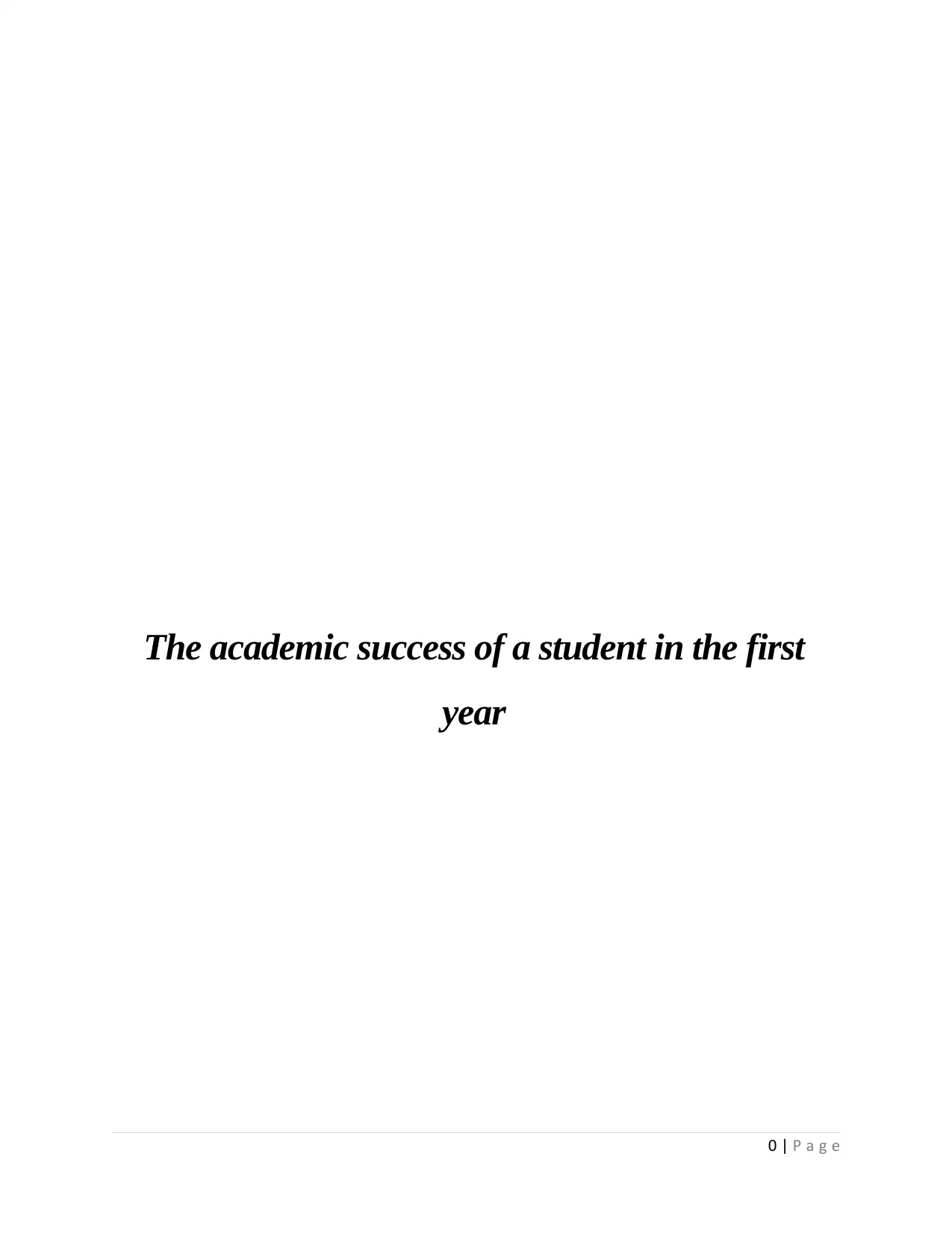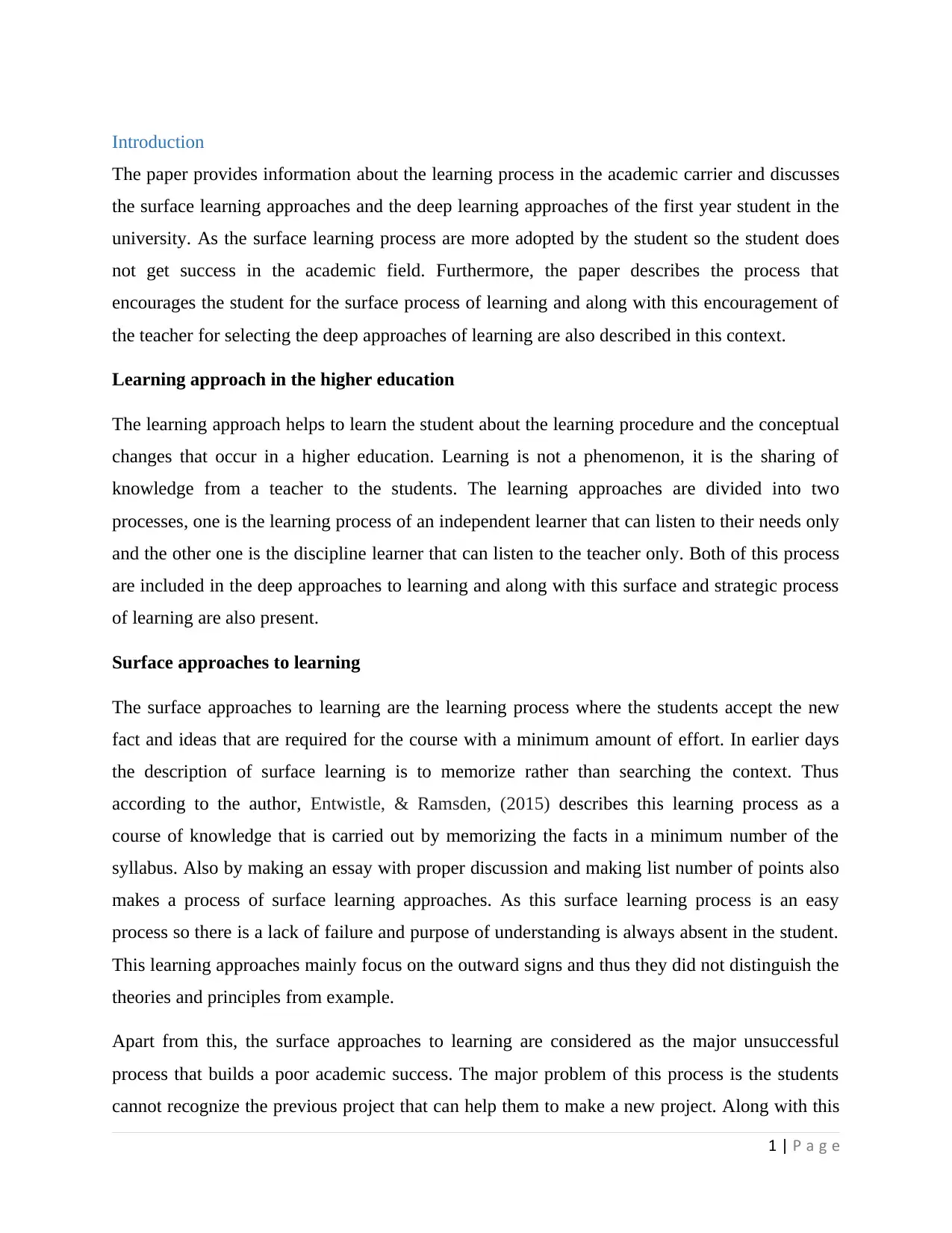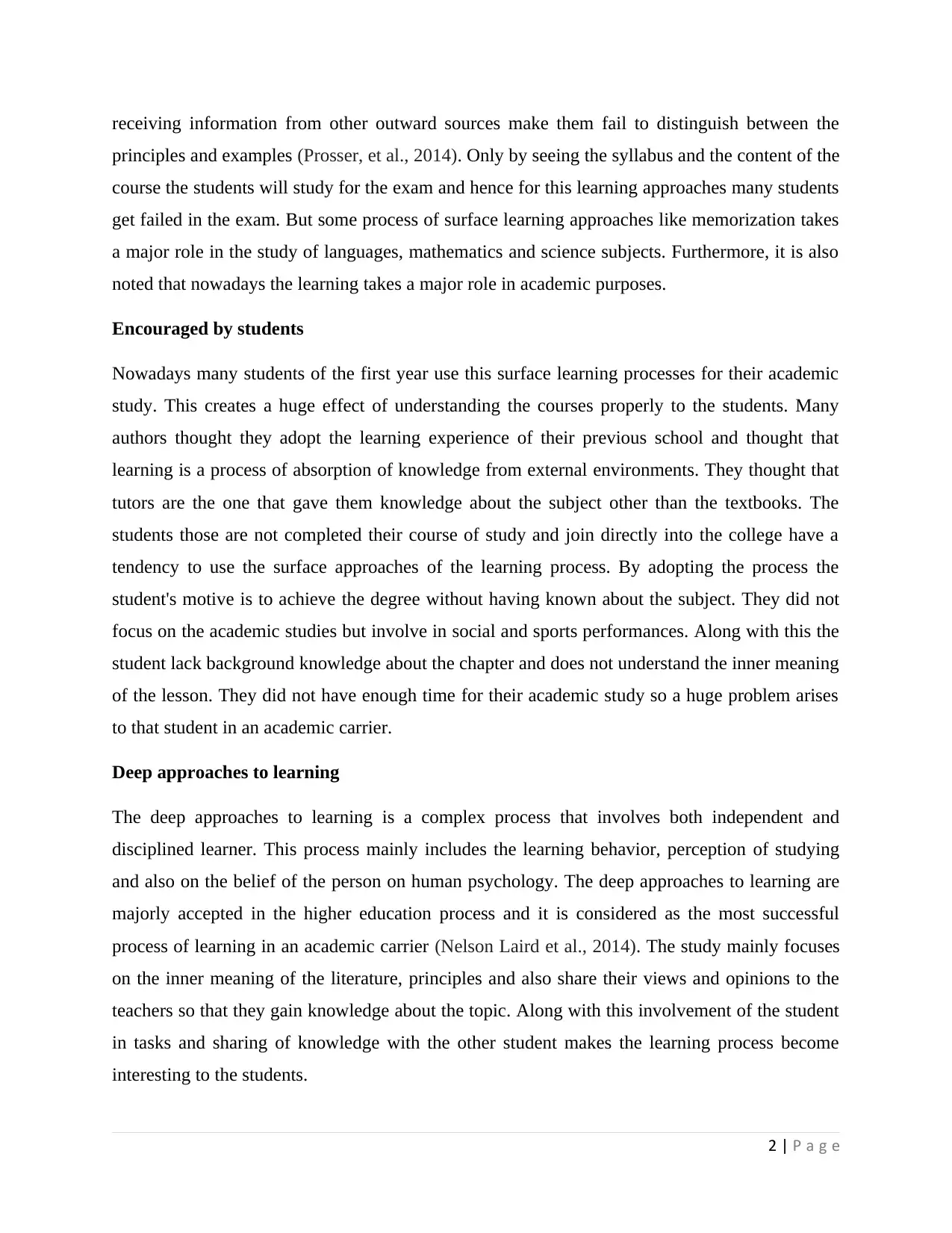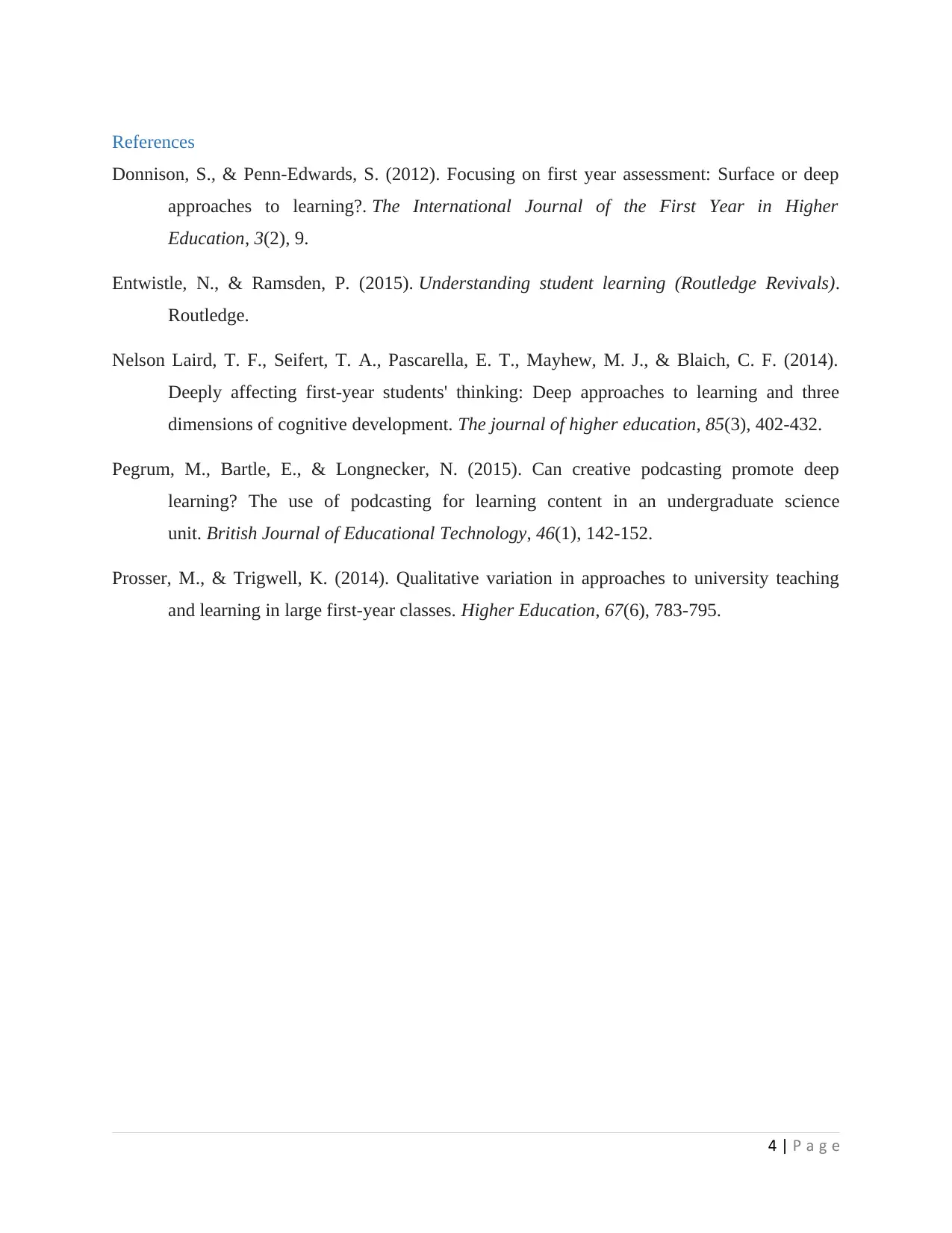Academic Success: Examining First Year Student Learning Approaches
VerifiedAdded on 2021/05/30
|5
|1526
|117
Essay
AI Summary
This essay delves into the learning processes of first-year university students, contrasting surface and deep learning approaches. It highlights how surface learning, characterized by memorization and minimal effort, often leads to academic challenges. In contrast, deep learning, involving critical thinking, engagement, and understanding, is presented as a more effective strategy for academic success. The paper discusses factors that encourage students towards surface learning, such as prior learning experiences, and also emphasizes the role of educators in fostering deep learning through active engagement, meaningful assignments, and interactive teaching methods. The essay underscores the importance of adopting deep learning approaches for improved comprehension and long-term academic achievement. The essay references several authors and their research to support the arguments made.

The academic success of a student in the first
year
0 | P a g e
year
0 | P a g e
Paraphrase This Document
Need a fresh take? Get an instant paraphrase of this document with our AI Paraphraser

Introduction
The paper provides information about the learning process in the academic carrier and discusses
the surface learning approaches and the deep learning approaches of the first year student in the
university. As the surface learning process are more adopted by the student so the student does
not get success in the academic field. Furthermore, the paper describes the process that
encourages the student for the surface process of learning and along with this encouragement of
the teacher for selecting the deep approaches of learning are also described in this context.
Learning approach in the higher education
The learning approach helps to learn the student about the learning procedure and the conceptual
changes that occur in a higher education. Learning is not a phenomenon, it is the sharing of
knowledge from a teacher to the students. The learning approaches are divided into two
processes, one is the learning process of an independent learner that can listen to their needs only
and the other one is the discipline learner that can listen to the teacher only. Both of this process
are included in the deep approaches to learning and along with this surface and strategic process
of learning are also present.
Surface approaches to learning
The surface approaches to learning are the learning process where the students accept the new
fact and ideas that are required for the course with a minimum amount of effort. In earlier days
the description of surface learning is to memorize rather than searching the context. Thus
according to the author, Entwistle, & Ramsden, (2015) describes this learning process as a
course of knowledge that is carried out by memorizing the facts in a minimum number of the
syllabus. Also by making an essay with proper discussion and making list number of points also
makes a process of surface learning approaches. As this surface learning process is an easy
process so there is a lack of failure and purpose of understanding is always absent in the student.
This learning approaches mainly focus on the outward signs and thus they did not distinguish the
theories and principles from example.
Apart from this, the surface approaches to learning are considered as the major unsuccessful
process that builds a poor academic success. The major problem of this process is the students
cannot recognize the previous project that can help them to make a new project. Along with this
1 | P a g e
The paper provides information about the learning process in the academic carrier and discusses
the surface learning approaches and the deep learning approaches of the first year student in the
university. As the surface learning process are more adopted by the student so the student does
not get success in the academic field. Furthermore, the paper describes the process that
encourages the student for the surface process of learning and along with this encouragement of
the teacher for selecting the deep approaches of learning are also described in this context.
Learning approach in the higher education
The learning approach helps to learn the student about the learning procedure and the conceptual
changes that occur in a higher education. Learning is not a phenomenon, it is the sharing of
knowledge from a teacher to the students. The learning approaches are divided into two
processes, one is the learning process of an independent learner that can listen to their needs only
and the other one is the discipline learner that can listen to the teacher only. Both of this process
are included in the deep approaches to learning and along with this surface and strategic process
of learning are also present.
Surface approaches to learning
The surface approaches to learning are the learning process where the students accept the new
fact and ideas that are required for the course with a minimum amount of effort. In earlier days
the description of surface learning is to memorize rather than searching the context. Thus
according to the author, Entwistle, & Ramsden, (2015) describes this learning process as a
course of knowledge that is carried out by memorizing the facts in a minimum number of the
syllabus. Also by making an essay with proper discussion and making list number of points also
makes a process of surface learning approaches. As this surface learning process is an easy
process so there is a lack of failure and purpose of understanding is always absent in the student.
This learning approaches mainly focus on the outward signs and thus they did not distinguish the
theories and principles from example.
Apart from this, the surface approaches to learning are considered as the major unsuccessful
process that builds a poor academic success. The major problem of this process is the students
cannot recognize the previous project that can help them to make a new project. Along with this
1 | P a g e

receiving information from other outward sources make them fail to distinguish between the
principles and examples (Prosser, et al., 2014). Only by seeing the syllabus and the content of the
course the students will study for the exam and hence for this learning approaches many students
get failed in the exam. But some process of surface learning approaches like memorization takes
a major role in the study of languages, mathematics and science subjects. Furthermore, it is also
noted that nowadays the learning takes a major role in academic purposes.
Encouraged by students
Nowadays many students of the first year use this surface learning processes for their academic
study. This creates a huge effect of understanding the courses properly to the students. Many
authors thought they adopt the learning experience of their previous school and thought that
learning is a process of absorption of knowledge from external environments. They thought that
tutors are the one that gave them knowledge about the subject other than the textbooks. The
students those are not completed their course of study and join directly into the college have a
tendency to use the surface approaches of the learning process. By adopting the process the
student's motive is to achieve the degree without having known about the subject. They did not
focus on the academic studies but involve in social and sports performances. Along with this the
student lack background knowledge about the chapter and does not understand the inner meaning
of the lesson. They did not have enough time for their academic study so a huge problem arises
to that student in an academic carrier.
Deep approaches to learning
The deep approaches to learning is a complex process that involves both independent and
disciplined learner. This process mainly includes the learning behavior, perception of studying
and also on the belief of the person on human psychology. The deep approaches to learning are
majorly accepted in the higher education process and it is considered as the most successful
process of learning in an academic carrier (Nelson Laird et al., 2014). The study mainly focuses
on the inner meaning of the literature, principles and also share their views and opinions to the
teachers so that they gain knowledge about the topic. Along with this involvement of the student
in tasks and sharing of knowledge with the other student makes the learning process become
interesting to the students.
2 | P a g e
principles and examples (Prosser, et al., 2014). Only by seeing the syllabus and the content of the
course the students will study for the exam and hence for this learning approaches many students
get failed in the exam. But some process of surface learning approaches like memorization takes
a major role in the study of languages, mathematics and science subjects. Furthermore, it is also
noted that nowadays the learning takes a major role in academic purposes.
Encouraged by students
Nowadays many students of the first year use this surface learning processes for their academic
study. This creates a huge effect of understanding the courses properly to the students. Many
authors thought they adopt the learning experience of their previous school and thought that
learning is a process of absorption of knowledge from external environments. They thought that
tutors are the one that gave them knowledge about the subject other than the textbooks. The
students those are not completed their course of study and join directly into the college have a
tendency to use the surface approaches of the learning process. By adopting the process the
student's motive is to achieve the degree without having known about the subject. They did not
focus on the academic studies but involve in social and sports performances. Along with this the
student lack background knowledge about the chapter and does not understand the inner meaning
of the lesson. They did not have enough time for their academic study so a huge problem arises
to that student in an academic carrier.
Deep approaches to learning
The deep approaches to learning is a complex process that involves both independent and
disciplined learner. This process mainly includes the learning behavior, perception of studying
and also on the belief of the person on human psychology. The deep approaches to learning are
majorly accepted in the higher education process and it is considered as the most successful
process of learning in an academic carrier (Nelson Laird et al., 2014). The study mainly focuses
on the inner meaning of the literature, principles and also share their views and opinions to the
teachers so that they gain knowledge about the topic. Along with this involvement of the student
in tasks and sharing of knowledge with the other student makes the learning process become
interesting to the students.
2 | P a g e
⊘ This is a preview!⊘
Do you want full access?
Subscribe today to unlock all pages.

Trusted by 1+ million students worldwide

Some of the first year students uses this deep approaches to learning for their academic purposes
although they use it in a limited manner. The deep approach to learning is not easily adopted by
the student due to the lack of experience, incapable of thinking beyond the course syllabus and
for many other problems (Donnison, & Penn-Edwards, 2012).. But nowadays engagement in a
deep learning process and in the task also shows a little development in their deep approaches to
learning over few years (Pegrum et al., 2015). By this deep approaches to learning a student
should focus on the central meaning of the topic and solve a problem easily. Along with this,
they interact with their classmate so that they differentiate between reasoning and logic. Apart
from this, they gain knowledge from different modules those are not present in their syllabus.
This student can do their task properly as they have the knowledge of their previous work.
Encouraged by teachers
Many students have adopted the surface approaches of study rather than the deep approaches of a
learning process. But the deep approaches of learning are mainly helpful for the study in
academic purposes. For making the student involvement more in this deep learning process the
teacher have to show the interest in the subject. The teacher should also describe the structure of
the lesson in an easy way or give some short of examples. By concentrating on the key points of
the module the time of teaching also reduced and hence the student gets more interest in it. The
teachers help the student to decrease their misconception on a particular topic by engaging them
in the active learning process. Apart from this by giving assignment and projects on weekly basis
also make the student know about the particular topic. By taking exams after the end of each
lesson also makes the student involved in the deep learning process.
Conclusion
Both learning outcomes have been adopted by the first year student of the academy. But it is seen
many students adopted the surface approaches of learning rather than the deep approaches of the
learning process as this process takes plenty of time for a topic to understand and so the student
avoid such process of learning. Hence it is concluded that making the student interest in the
subject is the main process of involving the student in the deep approaches to learning. Along
with this making of assignments and project also make them involved in this learning process.
3 | P a g e
although they use it in a limited manner. The deep approach to learning is not easily adopted by
the student due to the lack of experience, incapable of thinking beyond the course syllabus and
for many other problems (Donnison, & Penn-Edwards, 2012).. But nowadays engagement in a
deep learning process and in the task also shows a little development in their deep approaches to
learning over few years (Pegrum et al., 2015). By this deep approaches to learning a student
should focus on the central meaning of the topic and solve a problem easily. Along with this,
they interact with their classmate so that they differentiate between reasoning and logic. Apart
from this, they gain knowledge from different modules those are not present in their syllabus.
This student can do their task properly as they have the knowledge of their previous work.
Encouraged by teachers
Many students have adopted the surface approaches of study rather than the deep approaches of a
learning process. But the deep approaches of learning are mainly helpful for the study in
academic purposes. For making the student involvement more in this deep learning process the
teacher have to show the interest in the subject. The teacher should also describe the structure of
the lesson in an easy way or give some short of examples. By concentrating on the key points of
the module the time of teaching also reduced and hence the student gets more interest in it. The
teachers help the student to decrease their misconception on a particular topic by engaging them
in the active learning process. Apart from this by giving assignment and projects on weekly basis
also make the student know about the particular topic. By taking exams after the end of each
lesson also makes the student involved in the deep learning process.
Conclusion
Both learning outcomes have been adopted by the first year student of the academy. But it is seen
many students adopted the surface approaches of learning rather than the deep approaches of the
learning process as this process takes plenty of time for a topic to understand and so the student
avoid such process of learning. Hence it is concluded that making the student interest in the
subject is the main process of involving the student in the deep approaches to learning. Along
with this making of assignments and project also make them involved in this learning process.
3 | P a g e
Paraphrase This Document
Need a fresh take? Get an instant paraphrase of this document with our AI Paraphraser

References
Donnison, S., & Penn-Edwards, S. (2012). Focusing on first year assessment: Surface or deep
approaches to learning?. The International Journal of the First Year in Higher
Education, 3(2), 9.
Entwistle, N., & Ramsden, P. (2015). Understanding student learning (Routledge Revivals).
Routledge.
Nelson Laird, T. F., Seifert, T. A., Pascarella, E. T., Mayhew, M. J., & Blaich, C. F. (2014).
Deeply affecting first-year students' thinking: Deep approaches to learning and three
dimensions of cognitive development. The journal of higher education, 85(3), 402-432.
Pegrum, M., Bartle, E., & Longnecker, N. (2015). Can creative podcasting promote deep
learning? The use of podcasting for learning content in an undergraduate science
unit. British Journal of Educational Technology, 46(1), 142-152.
Prosser, M., & Trigwell, K. (2014). Qualitative variation in approaches to university teaching
and learning in large first-year classes. Higher Education, 67(6), 783-795.
4 | P a g e
Donnison, S., & Penn-Edwards, S. (2012). Focusing on first year assessment: Surface or deep
approaches to learning?. The International Journal of the First Year in Higher
Education, 3(2), 9.
Entwistle, N., & Ramsden, P. (2015). Understanding student learning (Routledge Revivals).
Routledge.
Nelson Laird, T. F., Seifert, T. A., Pascarella, E. T., Mayhew, M. J., & Blaich, C. F. (2014).
Deeply affecting first-year students' thinking: Deep approaches to learning and three
dimensions of cognitive development. The journal of higher education, 85(3), 402-432.
Pegrum, M., Bartle, E., & Longnecker, N. (2015). Can creative podcasting promote deep
learning? The use of podcasting for learning content in an undergraduate science
unit. British Journal of Educational Technology, 46(1), 142-152.
Prosser, M., & Trigwell, K. (2014). Qualitative variation in approaches to university teaching
and learning in large first-year classes. Higher Education, 67(6), 783-795.
4 | P a g e
1 out of 5
Related Documents
Your All-in-One AI-Powered Toolkit for Academic Success.
+13062052269
info@desklib.com
Available 24*7 on WhatsApp / Email
![[object Object]](/_next/static/media/star-bottom.7253800d.svg)
Unlock your academic potential
Copyright © 2020–2025 A2Z Services. All Rights Reserved. Developed and managed by ZUCOL.




